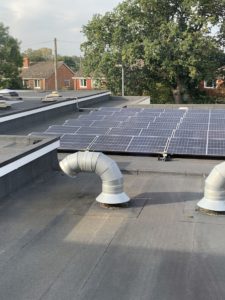TM54 OEP is one of our key services here at Buildpass. In this blog, we will be taking a closer look at how it could benefit your next building development journey.
Here at Buildpass, we love exploring new, exciting opportunities for operational efficiency. If it helps provide our clients with the best energy usage possible, we are ready to jump straight in and learn more. The TM54 OEG is no exception.
What is TM54 OEP? TM45 OEP is a Technical Memorandum published by CIBSE that focuses on energy usage in buildings and how the end result of the build’s energy cost and emissions does not always perform as well as the designers predicted.
TM45 OEP has many benefits. It helps builders to gain a better understanding of how to properly execute their design stage in the best way to evaluate operational energy use. However, even with TM45 OEP, there’s still some confusion with predicting Operational Energy Performance for new builds. In this blog, we will explore TM45 OEP in more detail and get rid of that pesky confusion.
What is TM54 Operational Energy Performance?
TM54 is a Technical Memorandum that addresses the growing awareness that buildings in operation do not always perform as the designers predicted. This can apply to both energy costs and emissions. There has been some growing awareness that ‘low energy buildings’ use more energy than the designers originally thought, resulting in typical energy bills for building owners. In response to this, CIBSE created TM54 Operational Energy Performance which calculates predicted in-operation energy use.
The TM54 Operational Energy Performance is great because it provides building designers with guidance on how to evaluate operational energy use fully and accurately at the design stage. It helps builders to understand how important it is to make an accurate estimate of the operating hours and occupancy of the building.
Thankfully, TM45 covers lighting, heating, ventilation and cooling and provision of hot water. It also considers lifts and escalators, server rooms and other plant and equipment, helping to catch sneaky energy uses that got missed previously.
Why is it important to predict energy performance at the design stage?
Estimating energy consumption before a building is built can flag up areas where the actual energy use would be higher than the estimated use. If we assess these areas at design stage, this will create the time and opportunity for builders to solve issues before the development begins and making alterations cheaper and easier to carry out. Overall, this ultimately makes the building more energy efficient with a lower energy bill for its occupant! Great, right?
One great way to predict your energy performance at the design stage is BREEAM. In order to get an estimation of the energy consumption of the building, the best place to start is an analysis of the occupants’ behaviour. Understanding how many people are expected to spend time in the building, when and what they use will help massively rather than mapping systems or construction details.
Once the builders understand the potential operational demand and how systems will be maintained within the building, they can make more appropriate informed decisions about the building design. Finally, the estimation will show the energy calculation of each relevant consumption category such as lights, domestic hot water, cooling, humidification and much more. This makes it easier to spot potential improvements, as well as arrests outside of the designer’s control, which helps to give a clearer picture of where to focus efforts.
What is the ‘performance gap’ and how can we avoid it?
Let’s explore deeper. Although new developments are seen to be hitting targets on paper, there’s evidence that suggests new buildings are not performing as well as predicted in the design-stage. This is known as the performance gap. ‘Performance gaps’ appear when not all energy uses are accounted for in modern compliance methods such as energy used by lifts, escalators and server rooms.
Previous studies have suggested that in-use energy consumption can be between 50% and 150% higher than estimated which is a crazy stat and one that needs to be brought down. And this is why TM45 OEP is so great. TM45 OEP makes sure to take into account energy used by lifts, escalators, server rooms, lighting, heating and so much more. The list could go on and on. However, there’s some other things that you can do to avoid the dreaded performance gap.
- Do not start the build until the design stage is finished and cleared
We strongly recommend that you make sure the design stage is completed before onsite building starts as this will avoid costly delays/errors and the need for construction details to be changed.
- Monitor and evaluate progress
Once the project has started, make sure to check on progress and that you maintain a regular quality evaluation. This will help to make sure you have not missed any energy uses and your build is perfect.
- Good communication across the construction team
It is so important to show and share the design goal all the way through with your team and external companies: all those responsible for designing, procuring and managing the construction project. This will help to keep you all on the same page and avoid any confusion.
- Check unregulated energy sources
Again, make sure to account for energy use from sources that are normally forgotten by designers, such as server rooms, equipment and much more.
Can Buildpass help me with TM54 Operational Energy Performance?
Yes! This is one of our core support areas and something we would love to advise you on. Please get in touch with a member of the Buildpass team for a free consultation.





















